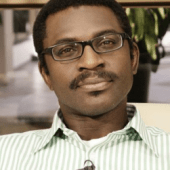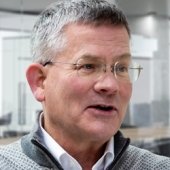IN BRIEF
- 7:50 - In the next few years, there’s going to be a lot of dynamism in how Scope 3 is going to be solved. The good news is that we are much better off now than we were a few months or a few years ago. There are a lot of companies who have convinced their supply chain that they need to share the data. We are seeing a lot more folks along the supply chain willing to commit to the data because they now understand it’s a global problem.
- 28:15 - I see a future where your EV will talk to an electric charging station at your grocery lot, and you could have the car and the station settle. You could be pumping EV there for 20 minutes, 23 minutes. They do a real-time settlement, and the car and the station have talked to each other and there’s probably a monetary transaction involved, and all of that done without any human involvement.
- 31:04 - As much as we hear about it, tech is still underrepresented in the quest for sustainability and emissions reduction, and I see tech playing a lot bigger role in the coming years. That’s my prediction.
In this VISION by Protiviti podcast, we’re exploring the future of ESG and its strategic implications for people, process, and the planet with Shy Muralidharan, Worldwide Energy Solutions Lead with Amazon Web Services, where he focuses on building solutions related to measurement and management of decarbonization initiatives for AWS customers and partners. For nearly two decades, Muralidharan has been a global leader in the areas of energy and sustainability, and he joins Aaron Ragusa and Jordan Svoboda, Protiviti Senior Managers with focus on ESG strategy and delivery, to talk data, data strategy and technologies of the future to help companies on their decarbonization journey across their value chains.
Shy Muralidharan is the Worldwide Energy Solutions Lead with Amazon Web Services (AWS), focused on building solutions related to measurement and management of decarbonization initiatives for AWS customers and partners. Shy has more than 17 years of global experience in product management, consulting and generating thought leadership in the field of energy and sustainability. Prior to joining AWS, Shy has worked in product leadership roles at organizations such as Engie Impact and Schneider Electric.
Aaron Ragusa is a Senior Manager in the Protiviti Houston office with a career focused in Managed Business Solutions, ESG Strategy and Delivery, and Business Performance Improvement.
Jordan Svoboda is a Senior Manager in the Protiviti Denver office with a career focused on Internal Audit and Financial Advisory and ESG Strategy and Delivery.
Podcast transcript
Joe Kornik: Welcome to the VISION by Protiviti podcast. I’m Joe Kornik, Editor-in-Chief of VISION by Protiviti, our global content resource looking into the future to examine big themes that will impact the C-Suite and executive boardrooms worldwide.
Today, we’re exploring the future of ESG and its strategic implications for people, process, and the planet, and I’m happy to welcome Shy Muralidharan to the program. Shy is the worldwide energy solutions lead with Amazon Web Services, focused on building solutions related to measurement and management of decarbonization initiatives for AWS customers and partners. For nearly two decades, Shy has been a global leader in the areas of energy and sustainability, and we’re so fortunate to have him with us on the program today.
Shy, thanks for joining us.
Shy Muralidharan: Thanks for having me, Joe. Good to be here.
Joe Kornik: I’m fortunate to be joined by two of my esteemed Protiviti colleagues today who will be handling the interviewing and leading a discussion on energy and decarbonization in 2030 and beyond. Let me introduce Aaron Ragusa and Jordan Svoboda, both senior managers at Protiviti. Jordan, I appreciate you helping me ask some of the questions today.
Jordan Svoboda: Yes. Thank you, Joe. Happy to be here as well.
Joe Kornik: Aaron, thank you as well. I’m going to turn it over to you, Aaron, to begin.
Aaron Ragusa: Thanks, Joe. Happy to be here. Shy, thanks for taking the time out to join with me and Jordan. I know we’ve met a couple of times briefly but when the topic came across for who can we talk to about ESG and what’s the future, Jordan and I instantly pulled your name up and said, “This is who we have to talk to,” just because the way that we think about it is, when we have the option to talk over the future, when we think about ESG is that there’s just this demand for data and information by not just companies out there but investors, consumers alike who really want to see transparency in the market. That’s going to be our topic for today. Looking forward to catching up with you. Thanks.
Jordan, you want to hit him with the first one?
Jordan Svoboda: Yes. Thank you, Aaron. I appreciate that.
Shy, really just diving into ESG overall, one of the big questions I wanted to ask you to kick this off was as businesses start to weigh ESG and sustainability over the next decade, what advice would you give senior leaders or what steps would you provide them to take right now to ensure success in the future?
Shy Muralidharan: Thanks. Thanks for the question, Jordan. First of all, I would start by saying that any action that you take is probably moving the ball forward and I would highly recommend that if you’re an executive or senior leader in an organization that can make an impact globally or locally within your own community, the first step is to make sure that you are taking some action in terms of decarbonization, sustainability, or anything related to ESG. We strongly feel that inaction is not going to help, and also the fact that this is a problem that has to be solved by a lot of cooperation and collaboration among several entities innovatively as sectors, and so it’s important that executives should start with, if they haven’t done already, measure, try to understand what is their carbon footprint, what is their carbon intensity of their operations. For them, they have to first figure out what is their current state in terms of what is the impact that they can make in reducing the overall carbon budget. That likely is the first step that everyone has to embark on.
Now, we do see that there are several organizations across the maturity spectrum that are doing that. Some of them started much earlier than others who are just starting now, but overall, I would say that if you want to make sure that you want to contribute to alleviating this problem, it’s important that you take some of those initial steps, right? This could mean that you might have to experiment or innovate and you might not always get it right the first time around, but it is that time that you’d spent iterating on what you need to do in the space. That will determine how successful you are. Given that this is a multidecadal problem to solve, we’re not going to see results tomorrow or day after. You have to invest in this for the longer term for you to really get to goals which are today set at 2030, 2040, or beyond.
Aaron Ragusa: I think how you close it up, Shy, it’s exactly how I think companies have really taken the road of having a longer deadline I think helps them out. I think it’ll just be “okay, yes, you’ve set these dates of 2030, 2040, 2050 but what are you doing to get there?” That’s where obviously the transparency and data processing that has to go through all of the processes that’s in a company are important. I think it’s great to have a goal and to put it out in the public, but let’s put up, I think, is what the companies need to do.
Jordan Svoboda: I think you’re picking up from that, right? From the idea from this new SEC rulemaking on ESG, I think one of the big points of contingence that we’re going to see, especially for energy companies and upstream companies in particular, is going to be around Scope 3 emissions and the data collection around that. How do you see data collection changing over the next decade that will allow for entities to report on Scope 3 emissions?
Shy Muralidharan: I think it’s first important to understand based on which sector you are to determine what percent of your emissions are Scope 3. We are seeing several sectors that are quite heavy on Scope 3, like oil and gas, chemicals, CPG, mining. All these sectors, a lot of the leaders in these sectors are reporting on 1 and 2 but yes, Scope 3 is where most of their emissions lie and unfortunately, today, they are not able to do a better job of reporting on their Scope 3.
Now, a big challenge with reporting out on Scope 3 is that they need the cooperation and collaboration of partners across the supply chain because Scope 3 is a lot about indirect emissions along your supply chain, so it is important that whether you are as a supplier contributing to components to make a product or contributing to some kind of service, it’s important that you work collaboratively with the organizations who make the most impact along your value chain and work together.
Now, we are seeing the reluctance of some of the vendors or organizations involved in this effort that, “hey, providing access to details related to my emissions might expose my business operations, the secret sauce that I have.” There is a way to collect data that is exclusive to tracking or measuring along these three scopes without necessarily providing details that make you uncomfortable.
Now, that is the challenge. We see a lot of companies start with just manually trying to collect information from their vendors, the right to determine their Scope 3, which means some of them are just sending out manual forms which they can fill out and you collect information voluntarily. Even that’s a good start. You don’t necessarily go all the way in terms of making sure that your supply chain data is of the best quality, which happens when you’re able to directly connect to systems of data within your supply chain without throwing too much tech jargon, if you want to use APIs that connect to a supplier’s operational system and you’re able to pull in real-time data that gives you very close, direct measurement of your Scope 3.
But I don’t think we are there yet and I want to present a realistic picture that the next few years, there’s going to be a lot of dynamism in how Scope 3 is going to be solved. The good news is that we are much better off now than we were a few months or a few years ago. There are a lot of companies who have convinced their supply chain that they need to share the data. We are seeing a lot more folks along the supply chain willing to commit to the data because they now understand it’s a global problem. We all have a single carbon budget that we have to bring down, so I think there’s a much better acknowledgment that we’ll only solve this through collaboration. We’re seeing that evolution in terms of the quality of data collected, the methods of data collection, and all of that.
Aaron Ragusa: Shy, you bring up a good point about commitment to the data, and I love your analogy of the secret sauce because we’ve had clients kind of bring that up to us, too, which is how much do I need to disclose of what are my operations? Do you think that this level of commitment just starts to get solved as more and more people adopt this level of transparency, or do you think that it takes kind of a banding of the chief information officers at organizations to say, “Hey, yes. We are going to be part of the solution, and my role is to make sure that we don’t give away that secret sauce. We give away valuable data points.”
Shy Muralidharan: Yes, that’s exactly right. I think it’s important for actors along, let’s say, a single supply chain to commit and trust each other and make sure that all actors along that supply chain do not break the trust. You have to ensure that you give the confidence to your suppliers that, “Hey, I’m collecting this data just for reporting purposes and I’m not going to misuse this.” Yes, so that’s where I would say a lot of the reluctance today lies, is that there aren’t enough examples either way, good or bad, of folks treating the emissions data that is shared Scope 3 in ways other than what it’s intended to. Now, we are hoping that this starts building trust as more and more companies report out on Scope 3 and more suppliers get comfortable with sharing their data with folks downstream in their value chain.
You will see the moment — I think we’re all waiting for the tipping point when you have enough suppliers or folks along the supply chain who are sharing data downstream. If they get the confidence that, okay, this data is not going to be misused and there’s overall good in all of us sharing this data, I think we’ll see a lot more momentum, but like a lot of other things, this is early days and we have to get over this initial hump.
Jordan Svoboda: Yes. That’s a great point, Shy. Even from that perspective, too, if a supplier is unwilling to share that data, I think a lot of the conversations I’ve had with my clients have started going around vendor selection. Part of the attributes that they take to that process is, can we get some of this ESG data that we need because our investors, regulatory bodies require that information from us, so we require that from our vendors, which then starts trickling down the line to that vendor selection process, which I think is an interesting development that will probably continue to take place over the next few years.
Obviously, a big portion for us with energy utilities, the E in ESG is obviously the main focus, the main driver, but what about the other two areas for you, Shy, here around social and governance? The SG of ESG, how do you see energy in utility companies utilizing that data in these areas by 2030?
Shy Muralidharan: Most customers start with the E of ESG because that’s the most quantifiable. You can back down emissions related to carbon and more to do with all the resources that are in play for any kind of sustainability transformation. Whether that’s energy, water, waste, all of those resources, it’s much easier to quantify them. You have systems in place that allow you to see how much you’re procuring energy or water, how you’re consuming it. I’m not saying that it has been adopted across all organizations, but there at least exists a technology for you to quantify how these resources are procured, utilized, recycled, and all of those through the lifecycle of those resources.
Now, with S and G, you do not have that same clarity in terms of how to quantify some of those, right, because the topics themselves in S and G include things like human rights and diversity and quality of governance. It’s extremely difficult to quantifiably measure and/or benchmark those metrics and by that very nature of those metrics, folks tend to deprioritize them. That’s what is going on. I would say I think that naturally so, people, a lot of leaders in the energy and utility space are prioritizing the E of ESG, but we are seeing more and more. We have a lot of customers who ask us, “Hey, I need to track some metrics related to human rights and diversity,” and it’s coming up a lot in conversations. Again, I think if I said earlier, it’s early days for overall sustainability reporting, it’s way more early days in terms of the S and G part of it.
But folks are starting with trying to aggregate third-party scores and ratings and trying to use sector averages. A lot of economic modeling is going on. Estimations are going on. The challenge will be that with the E part of it, you are able to nicely transition from economic modeling and estimation to more direct measurement to the point of source of, let’s say, carbon emissions or any other kind of emissions that make a difference to the overall carbon budget.
With S and G, I am not sure there’s a clear path for them to move to a quantifiable outcome. There is an expectation from a lot of the regulatory bodies that there is more quantifiable modeling done around those metrics and some of the organizations, honestly, when we talk to them, they are saying, “We’re just waiting for additional clarity around how to report out S and G.” They are doing it in part now. There are metrics like executive compensation or how do ESG goals tie into executives’ objectives, and how is your board structured in terms of having enough of these ESG metrics represented by board members? There are some metrics coming in but I think it’s a space that likely will evolve a lot in the coming decade.
Jordan Svoboda: I tend to agree with you from everything I’ve seen as well where if there’s a spectrum of this reporting, E is definitely first in line, followed by probably S and G pretty close together for a few years earlier in the development from there as well.
Aaron Ragusa: It’s a nice transition that we set up here. As we’re talking about S and G, we’re talking about how folks interact with any companies and that change in dynamic, what Jordan and I wanted to pick your brain about is more the energy space and how the energy landscape seems to be changing. I feel like in your world, data and transparency, the data point that every consumer has had at their fingertips since, I don’t know, forever is the price at the pump. How much am I paying for fuel? How much am I paying on my electric bill, on my gas bill? I was just wondering how do you see data being used to drive both suppliers, so E&U companies, and consumer decisions through 2030?
Shy Muralidharan: The challenge there is not so much data. We’ve always had data in that space for several years now. The challenge is to put all of them together and orchestrate the data from multiple sources. To give you an example, if I’m an energy retail supplier or if I’m a consumer of an energy retailer and I have a mix of traditional fossil fuel energy supply with some element of renewable energy supply, now I have a multitude of suppliers who are providing energy with varying levels of carbon emissions or carbon impact. It is important that I’m able to reconcile data from all these suppliers, whether that’s a traditional fossil fuel or brown energy suppliers with some of these green energy suppliers, not all of them have data at the same spatial and temporal granularity. You see now a lot of renewable energy projects that provide data by the hour or by the minute because they are solar and wind farms that have the tech enabled to provide more granular data, compared to a lot of traditional fossil fuel plants which do not have that level of granularity. We are definitely seeing a lot of, I would say, the incumbent players there trying to up their tech and making sure that they are able to supply more real-time data, but it doesn’t exist as an industry. You have to go in and retrofit a lot of tech there to make sure that you’re getting that same level of granularity that we are seeing with some of the newer energy companies.
Now, that itself becomes a challenge, as a consumer, in that I now have to reconcile data. I have to put it together. I have to come up with a normalized score of what is the impact of my energy procurement strategy or if I can come up with a single CO2 equal a number to the quality of the energy that I procure, it is not easy. It’s a lot of manual number-crunching and you sometimes don’t — even large organizations that we talk to really struggle with this problem.
Now, that becomes an issue for the decision-makers if you don’t have the quality of data at the right resolution and the right granularity. That shows up in the quality of decisions that you take in terms of either a broader sourcing strategy or now, honestly, a topic that’s very timely is that people have to balance how they respond to climate change with energy security, which has come up all the way down to the fuel price at the pump. It’s like how do I balance these two goals and do I have the data to do it? Unfortunately, a lot of them don’t. They are trying their best but they tend to then lean towards one or the other. Some of them have gone on record to say that they will continue to keep their commitments to climate change and everything that they’ve been doing around emissions reductions, and others who have leaned heavily on the other side and said, “No, we’re going to park all of that for a few months or years while we get our energy security in place.” There’s a select few who are able to balance both and trying to go up the tightrope between those two objectives. That’s how we are seeing data being used.
With consumers, I probably split that up as B2B and B2C consumers, folks like you and me. There’s a lot of data that doesn’t — I would say we have the data again that will help us take those decisions, but I am not sure we have all the right products. It depends on the market you are in, how regulated or deregulated it is. How much information, even if you are in a deregulated market, can you use to take those decisions? We probably have to wait a few months or a few years at least before we have the quantity of data that allows us to make real-time decisions.
Interestingly, there are several utilities who have even come to us with that same problem and they want to give more decision-making at the hands of their consumers and have asked us, “Hey, can AWS come in and help with the tech to do that?” At least, that’s a good sign. We haven’t had those conversations earlier, so we are seeing more and more of that coming up in a lot of discussions, which means that that makes me optimistic that I think in the future, there’s going to be more data and decision-making power in the hands of the consumer.
That also ties in nicely with the overall decentralization of the energy industry. You’re using more distributed energy resources, microgrids, and other initiatives that are moving all the decision-making and the data away from a decentralized grid actor to more decentralized actors.
Aaron Ragusa: The way that we’ve talked about it in the past is — and I think you are just getting into it — I think in the past, there was a very large separation in what a consumer did and how a business operated. I’m not sure if it’s just the synchronicity with ESG starting up, but it seems like employees have more power than ever just to speak and make change. With energy being such a hot topic right now, that just seems to be what we hear about, largely, the E being dominant as Jordan said. I guess it’s like the S influencing the E.
Another point to build on is as you hear more consumers demanding more transparency through data, where do you see that future going? What is kind of what you’re excited about? What is the next piece of technology coming down the pike that — you don’t have to disclose the secret sauce at AWS, but what are you excited about that piques your interest?
Shy Muralidharan: I think what I’m most excited about is to have more real-time data influence the decisions. That is whether it is consumers or various actors along the energy value chain, all the way from generation through distribution of energy, in one way or the other, whether that’s a barrel of oil, whether that’s a unit of 1 kilowatt of energy. However, you get to the endpoint of that energy. The amount of data that folks are trying to layer on to these value chains is just exploring the potential of what you can do with the data. Yes, we have to be wary of making sure that you don’t end up with too much data. When we help customers, it’s like solving for data using data lakes and they say, “Oh, you don’t want it to end up with a data swamp.”
Aaron Ragusa: Got you. I like that.
Shy Muralidharan: People talk about data obesity now, which is too much data, you really don’t know what to do with it, and so you end up not doing anything with it because you’re just like the typical “deer in the headlights” situation and you’re just staring with too much data and you really don’t know which way to move.
That is an important part of making sure that we solve for the right amount of data and use it for decision support to make the decisions related to making sure that you’re able to reduce emissions across your value chain. Even helping others downstream. The important topic with Scope 3 is that a lot of times folks do not realize how much of an impact their product can have once it leaves their gate. We talk about this entire cradle-to-grave emissions tracking of products and services, which means from the first point of origin of the first component of the product all the way to end-of-life of the product. Sometimes, organizations are just focused on getting their product out of their gate, so there’s a cradle-to-gate piece but once it leaves their gates all the way to end-of-life, to the grave of that product, there’s a lot of emissions, which is why it’s important to get involved heavily in making sure that you’re tracking your Scope 3 effectively.
People talk about redundancy and double counting and all of that. I actually — to those folks who always say that, “Oh, in Scope 3, there’s a lot of double counting and I don’t think it’s an effective method to do it.” If you’re really going to the nature of Scope 3, I’d say double counting is a feature, not a bug. It is intended. There is no requirement for you to make sure that you’re not double counted. The idea is that you get folks across the supply chain and the demand chain as much as possible, track all your emissions. One man’s Scope 1 is another man’s Scope 3, and vice versa sometimes, right?
It’s okay to — I don’t think double counting is the biggest issue to tackle there. It’s important that everybody tracks their emissions effectively, and you start with some kind of measurement, like folks who do not measure, you’re not even accounting for the emissions, and then you don’t even have a stake in the ground in terms of talking about can you reduce emissions or not. It’s first importance, start with measurement and the old adage, you cannot manage what you cannot measure. Start with measurement so that then you can get into effectively managing your emissions.
Aaron Ragusa: I love that, cradle-to-gate, gate-to-grave. That just makes it so clear to me. I feel that as a consumer, too, especially now, sometimes I look at what we bring into the house or what we buy and then I wonder where this is all going, like how many times — what did it take to get to me and then what does it take to get once I’m done with it.
Jordan Svoboda: I think even jumping in with the idea of — Shy, you had mentioned consumer-driven demand and having very detailed, almost individualistic demand drivers from the consumer level. If me as a consumer can make decisions in real time from a utilities companies saying, “I want to switch from natural gas-provided electricity to wind power or solar power or hydropower,” real-time throughout the day to make either the best decisions financially or the best decisions maybe from a moral decision, if that makes sense, that’s a very interesting concept. I agree with you about the idea of data obesity, where maybe I don’t have time to make those decisions throughout the day, so I just default to whatever is easiest or whatever is cheapest, or maybe I just set my default to, I want what’s the most green choice that I can make from there. There’s an interesting balance I think that’s going to have to be figured out over the course of the next few years.
Shy Muralidharan: That’s right, yes. Data obesity is real. You see that being discussed a lot with our customers. With a lot of large organizations who have mature systems for data acquisition, they have all the data as required. I think it’s important to extract and curate the right data that you need for decision support.
Sometimes you don’t have to be comprehensive about it. Sometimes there is a drawback. You’d rather get some initial decision-making going with the data that you have and it could just be a few data variables that you can use to make a decision, and then get into refining it and fine tuning it to greater levels of accuracy.
Aaron Ragusa: Shy, one of the biggest, I think, newest, I guess, industry to come about is the crypto currency industry and when I think about it, it’s very intriguing because it is kind of — obviously, there was always an energy cost to produce a dollar in the United States or produce a metric of currency, but cryptocurrency has easily been branded as this new potential future currency that is very high in energy demand. I just wanted to see if that has come across your desk at all as something that we could see growing over the next 10 years. If so, what are your thoughts on that?
Shy Muralidharan: The one thing that excites me is the underlying technology of blockchain. Blockchain has the technology…
Aaron Ragusa: Yes, and you said “chain” a couple of times in the past questions, and it’s like yes, exactly right.
Shy Muralidharan: Overall distributed ledgering of information, things like smart contracts that allow you to do settlement in real-time or near real-time, a lot of the underlying technology that has manifested as cryptocurrency. I think cryptocurrency is one of the manifestations of the underlying blockchain technology. The technology itself is great. I think to the world, it’s given a technology that can apply for a lot of the decentralization that’s coming into the energy value chain overall. I see a future where your EV will talk to an electric fuel station, a charging station at your grocery lot, and you could have to the car and the station settle like you could be pumping EV in there for like 20 minutes, 23 minutes. They do a real-time settlement and the car and the station has talked to each other and there’s probably monetary transaction involved, and all of them done without any human involvement.
A future like that is quite exciting, which is why I totally support the technology but in terms of cryptocurrency itself, the idea of tokenizing, I think it is like the internet in the 90s. I think there’s going to be a lot of models that people try out. There are going to be winners and losers, and we see some interesting players there. I don’t want to take any names but some of them who we think have more sustainable business models compared to the others. But yes, overall, as I said, I love the underlying tech. I think there’s a lot of promise there, especially in the decentralized energy world of the future.
We are now seeing blockchain-driven microgrids or blockchain-driven peer-to-peer trading of energy. If you have community rooftop solar within a community and if you want to have trading between two houses within the same community around their rooftop solar generation and if one is overproducing and the other is underproducing and if they want to share that. Or collectively as the entities within a community, if they want to trade with another community, I think the possibilities are endless with the underlying tech. I think it’s important to get it right, and we’re still waiting for those blockchain-enabled technology that can go mainstream, I think. I’m sure it will happen in the next few years.
Aaron Ragusa: I’ve got one last question for you to bring us home. When you think of an intersection of ESG, sustainability and energy, any predictions about where we’re going?
Shy Muralidharan: I actually would like to use a quote from the BlackRock CEO who said that a lot of the tech for climate tech has not been invented yet. I think my prediction is that we are going to see tech that we probably don’t see in the world right now to be used to solve for some of these problems around that and overall emissions reduction and such. My prediction is that it’s a great time to be alive and I’m looking forward to tech that’s not invented yet.
We talk to a lot of startups. We talk to a lot of early-stage companies while working on really cool tech. I also strongly think that as much as we hear a lot about it, tech is still underrepresented in the quest for sustainability and emissions reduction, and I see tech playing a lot bigger role in the coming years. That’s my prediction. Now, that’s the only way we’ll get to the scale that we have to and the goals that we have to by 2040 or 2050. It’s important to have the tech sector along with the energy sector go hand in hand to get to those goals.
Aaron Ragusa: Well, Shy, that’s all I’ve got for you today. Don’t be surprised if you see my name in your inbox again to just chat. This has been great and I really appreciate the time.
Jordan Svoboda: Yes, Shy. I’ll echo what Aaron said here as well, maybe even with the inbox message, too, but definitely appreciate your insights on this and your time sharing all of your information with us today.
Shy Muralidharan: I thoroughly enjoyed the discussion. Thanks for having me and I always enjoy talking about the future. That’s something that I’m really passionate about.
Aaron Ragusa: Thanks, Shy.
Jordan Svoboda: Perfect. Then Joe, I think we can pass it back over to you.
Joe Kornik: Thanks, Jordan. I appreciate that, and thanks, Aaron, and thanks, Shy, for that great discussion around energy and AWS and the future. A really interesting discussion.
Thank you for listening to the Vision by Protiviti Podcast. Please rate and subscribe where you listen to podcasts, and be sure to visit us at vision.protiviti.com and subscribe to sharpen your Vision.
On behalf of Aaron, Jordan, and Shy, I’m Joe Kornik. Thanks for listening. We’ll see you next time.
Did you enjoy this content? For more like this, subscribe to the VISION by Protiviti newsletter.


































